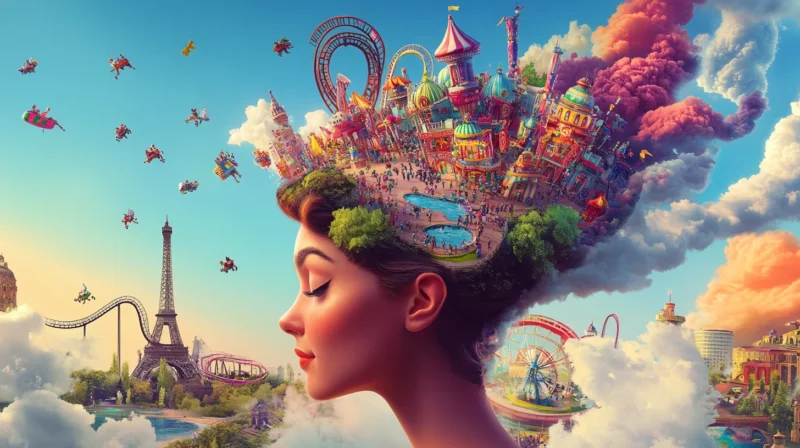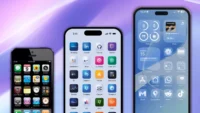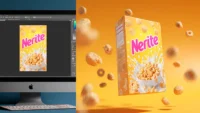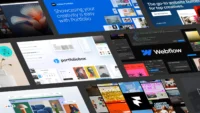In this article:
- 1. Gaming
- 2. Interior Design
- 3. Music
- 4. Food and Beverage
- 5. Film and Theater
- Tips for Finding Cross-Industry Inspiration
- The Importance of Context
- Staying Curious and Open to New Ideas
Hitting a creative wall is common in the design industry. How can you reignite that spark after looking through hundreds of layouts? It starts with paying attention to areas you are least likely to look at — industries that communicate visually offer a wider palette of creative possibilities. When you explore the most unexpected places, you can revitalize your work.
1. Gaming
The video game industry bursts with design inspiration at every level. Valued at $217 billion in 2022 and projected to grow at a 13.4% compound annual growth rate through 2030, it is more than a place for entertainment. It is a full-blown art form, and as a designer, I think it is one of the richest playgrounds to study.
From lush open worlds to stylized indie games, the visual language of gaming is constantly growing. I have even paused mid-quest in The Elder Scrolls V: Skyrim to take in the glowing mushrooms of Blackreach or the intricate detailing on a Dwemer ruin.
Designers in the gaming world are masters of mood, atmosphere and interface — and there is a lot we can borrow from that. Every title can show you how illustration and animation elevate storytelling.
They also offer lessons in environmental structure and cinematic composition. You will find all kinds of influences from these digital experiences. So, try looking at a game trailer or a concept art portfolio of your favorite RPG and see if you can come up with your next breakthrough.
2. Interior Design
Interior design is one of those industries that lives and breathes aesthetics. Each room creates an intentional environment, involving a layering of textures and colors.
One of my favorite things to borrow from interior decorating is its approach to color. For instance, I often follow award-winning colors. One example is Benjamin Moore’s Color of the Year 2025 — Cinnamon Slate, which is a grounded, warm-toned neutral. When paired with tones like Sea Salt or Leather Saddle, it creates a soft or bold look that can complement other elements in a room.

Get 300+ Fonts for FREE
Enter your email to download our 100% free "Font Lover's Bundle". For commercial & personal use. No royalties. No fees. No attribution. 100% free to use anywhere.
These combinations are a goldmine for when you are working on brand palettes or web design. They can make a curated look that is current with today’s trends.
However, interiors teach us more than color integration — they also offer lessons on negative space, layering and visual flow. How furniture placement guides foot traffic is similar to how your layout guides a reader’s eye across a page.
3. Music
Music and graphic design go hand in hand, especially when crafting identity. Album covers, music videos, stage visuals and social media posts are things artists rely on to extend their sound into a visual story. Charli XCX and the bold visual tied to her Brat album is a compelling example.
Instead of leaning into a polished look, Brat embraces what is known as anti-design — a rebellious trend that is intentionally unrefined. With flat colors and stretched type, these visual choices break the “rules” of traditional formatting. Even though it is loud and unapologetic, it makes you look twice in a world saturated with sameness.
Music marketing is a fast track to understanding how creativity can elicit emotion and cultivate community. Fans want more than being able to listen to a soundtrack — they want the full experience so they can escape into that artist’s world. One key point to take away from the music industry is to think about how to step outside your comfort zone to immerse your audience with a different sense of things.
4. Food and Beverage
Food and beverage branding has become an area for bold design moves. Look at the Poppi soda cans — they are always bright, bubbly and fun. Its playful typography, vibrant colors and minimalist layout instantly tell you it is not your average drink.
This industry sure knows how to capture attention. But beyond branding, the cooking process can be surprisingly reflective of the creative approach to design.
When I am in the kitchen, I have noticed how closely making food mirrors design thinking. You start with the core ingredients — like your typefaces, colors and imagery.
Then, you experiment with different combinations until you find the perfect balance. A pinch too much, and you throw the whole thing off. Too little, and it falls flat. Much like plating a dish, composition in design is about guiding the eye, creating contrast, and making something functional and beautiful.
Visually, food brands are often the most daring. Each uses design to communicate flavor, vibe and lifestyle. There is a reason creators love a well-styled food shoot or a beautifully branded cafe, as they tell stories you can almost taste.
5. Film and Theater
Productions such as film and theater will, of course, always be the gold standard for visual storytelling. The cinematography and poster layouts are rich with inspiration for graphic designers. Every detail sets a tone and carries a narrative — elements we all aim to achieve in design.
Take the instantly recognizable font of Harry Potter, for example. The lightning bolt “P” alone creates a whole world of enchantment, magic and mystery.

That is the power of typography in film — it becomes part of the storyline in a movie. This is all because movies build identity and drive emotion. If the film becomes iconic enough, it has the power to drive every aspect of design for fans.
When I look at movie posters or film intros, I try to envision the types of layouts I could create. There is much to learn from how designers play with scale and contrast to hook you in seconds. If you want to sharpen your storytelling, analyzing the visual concepts of film is a great place to start.
Tips for Finding Cross-Industry Inspiration
Sometimes, the best place to look for new ideas is outside your usual creative lane. When seeking inspiration from other industries, here are a few tips to make it part of your creative process.
1. Follow Design Sites and Platforms
Keep tabs on trends by following websites like Dribbble, Behance or Awwwards. Many share creations drawn from fashion, architecture, technology and more.
Following your favorite designers on Instagram or Pinterest is also a good idea. These social media sites are visual platforms full of creatives worldwide. Consider searching for interior decorators or photographers with curated collections from their travels.
2. Attend Design Conferences and Workshops
There is no substitute for being in a room full of creatives. Whether it is a design-focused event or a multidisciplinary conference, these spaces offer a chance to see how others are solving creative challenges.
Plus, you get to make new connections and ask questions. It can be surprising how one conversation can lead to a passion project.
3. Experiment With New Tools
Trying out new software or apps can change how you approach visual storytelling. Even if it is a simple collage tool, it could lead to something you would not have considered using in your usual workflow.
This concept is similar to how you switch up your daily routine. Sometimes, using a new tool is like taking a different route to work. It can give you a different perspective and fuel your creativity as you take in the new surroundings.
When you interrupt your day, you think more critically. This is evident in research, as studies show that disruption generates 58% more ideas than those left uninterrupted.
4. Keep a Swipe File
If you see a design that makes you pause, save it immediately. You will need it later when you want to strike inspiration for your next project.
However, it is crucial to keep your visual references organized. That is the purpose of a swipe file. Whether digital or physical, a swipe file gives you a library of fresh ideas when you need them fast.
5. Create Mood Boards
Mood boards take your inspiration and turn it into something tangible. Pull together imagery, color palettes and textures from different fields to connect seemingly unrelated ideas into a cohesive visual direction.
The Importance of Context
Finding inspiration is only the first step — knowing how and when to use it is where the real work begins. Context shapes how ideas land, so it is essential to filter outside inspiration through the lens of your specific project. Here is what to keep in mind:
- Target audience: Always consider who you are designing for. What resonates with one group may alienate another. Design inspiration should ultimately support user connection, not just aesthetic appeal.
- Brand identity: Make sure the inspiration aligns with the brand’s values, tone and personality. A slick, tech-inspired interface may look great, but it may not be the right fit for a brand built around rustic charm or whimsy.
- Project goals: What message are you trying to convey? Whether trust, energy or elegance, your ideas should support the emotional and strategic outcome you intend to achieve.
- Medium and format: What looks good on a billboard may fall flat on a mobile screen. Think about where your design will live and how that context affects layout, scale and interaction.
- Functionality: Even if you have a beautiful art concept, it still needs to work seamlessly. Consider how your elements support user experience, especially if you place them across various platforms.
Staying Curious and Open to New Ideas
Inspiration shows up when I least expect it, and it can for you, too. By diving into industries you have yet to explore, you can widen your perspective and build a more creative voice.
The more you train yourself to notice patterns in unexpected places, the bigger the chance you have at designing work that stands out. So, permit yourself to look outside the usual design bubble and discover what sparks your next great idea.




